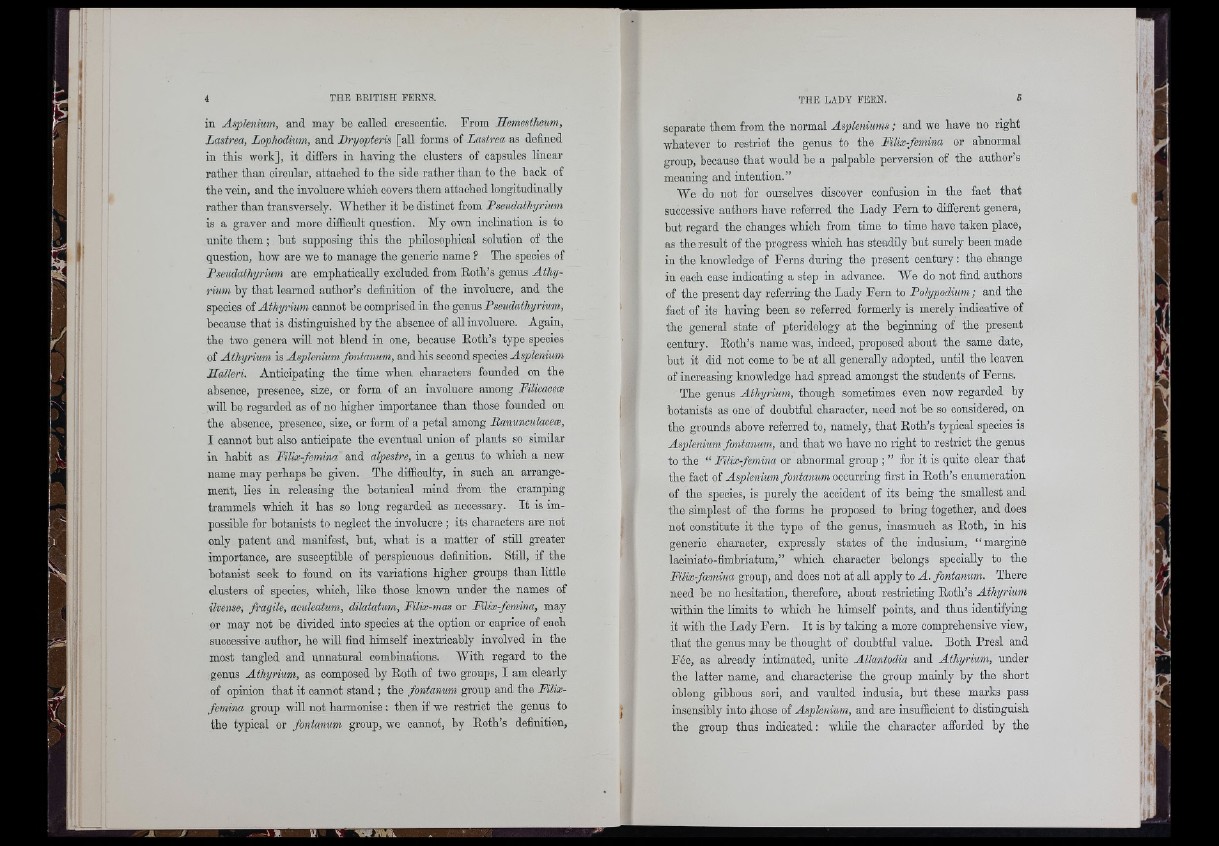
in Asplenium, and may be called crescentic. From Semestheum,
Lastrea, Lopliodium, and Lrxjopteris [all forms of Lastrea as defined
in this work], it differs in having the clusters of capsules linear
rather than circular, attached to the side rather than to the hack of
the vein, and the involucre which covers them attached longitndinally
rather than transversely. Whether it he distinct from Pseudatlnjriwn
is a graver and more difficult question. My own inclination is to
unite them ; hut supposing this the philosophical solution of the
question, how are we to manage the generic name ? The species of
Pseudathxjrimn are emphatically excluded from Eoth’s genus Athy-
rium by that learned author’s definition of the involucre, and the
species of Athyrium cannot he comprised in the genus Pseudathyrium,
because that is distinguished by the absence of all involucre. Again,
the two genera will not blend in one, because Eoth’s type species
of Athxjrium is Asplenium fontanum, and his second species Asplenium
Hallei'i. Anticipating the time when characters founded on the
absence, presence, size, or form of an involucre among Pilicaeeæ
will he regarded as of no higher importance than those founded on
the absence, presence, size, or form of a petal among Banunculaceæ,
I cannot hut also anticipate the eventual union of plants so similar
in habit as Pilix-femina and alpestre, in a genus to which a new
name may perhaps be given. The difficulty, in such an arrangement,
lies in releasing the botanical mind from the cramping
trammels which it has so long regarded as necessary. It is impossible
for botanists to neglect the involucre ; its characters are not
only patent and manifest, hut, what is a matter of still greater
importance, are susceptible of perspicuous definition. Still, if the
botanist seek to found on its variations higher groups than little
clusters of species, which, Hke those known under the names of
ilvense, fragile, acxileatum, dilatatum, Pilix-mas or Pilix-femina, may
or may not he divided into species at the option or caprice of each
successive author, he wül find himself inextricahly involved in the
most tangled and unnatural combinations. With regard to the
genus Athyrium, as composed by Roth of two groups, I am clearly
of opinion that it cannot stand ; the fontanum group and the Pilix-
femina group will not harmonise ; then if we restrict the genus to
the typical or fontanum group, w'e cannot, by Eoth’s definition.
separate them from the normal Aspleniums ; and we have no right
whatever to restrict the genus to the PilixfemixM or abnormal
group, because that would he a palpable perversion of the author’s
meaning and intention.”
We do not for ourselves discover confusion in the fact that
successive authors have referred the Lady Fern to different genera,
hut regard the changes which from time to time have taken place,
as the result of the progress which has steadily but surely been made
in the knowledge of Ferns during the present century : the change
in each case indicating a step in advance. We do not find authors
of the present day referring the Lady Fern to Polypodium ; and the
fact of its having been so referred formerly is merely indicative of
the general state of pteridology at the beginning of the present
century. Roth’s name was, indeed, proposed about the same date,
but it did not come to he at aU generally adopted, until the leaven
of increasing knowledge had spread amongst the students of Ferns.
The genus Athyrium, though sometimes even now regarded by
botanists as one of doubtful character, need not he so considered, on
the grounds above referred to, namely, that Roth’s typical species is
Asplenium fontanum, and that we have no right to restrict the genus
to the “ Pilix-femina or abnormal group ; ” for it is quite clear that
the fact of Asplenium foxitanum occurring first in Roth’s enumeration
of the species, is purely the accident of its being the smallest and
the simplest of the forms he proposed to bring together, and does
not constitute it the type of the genus, inasmuch as Roth, in his
generic character, expressly states of the indusium, “ margine
laoiniato-fimhriatum,” which character belongs specially to the
Pilix-foemina group, and does not at all apply to A. fontanum. There
need he no hesitation, therefore, about restrictiug Roth’s Athxjx'ium
within the limits to which he himself points, and thus identifying
it with the Lady Fern. It is by taldng a more comprehensive view,
that the genus may be thought of doubtful value. Both Presl and
Fée, as abeady intimated, unite Allantodia and Athyrium, under
the latter name, and characterise the group mainly by the short
oblong gibbous sori, and vaulted indusia, but these marks pass
insensibly into those of Asplenium, and are insufficient to distinguish
the group thus indicated: while the character afforded by the
! ’ i
, f i
I-1
1'
h |